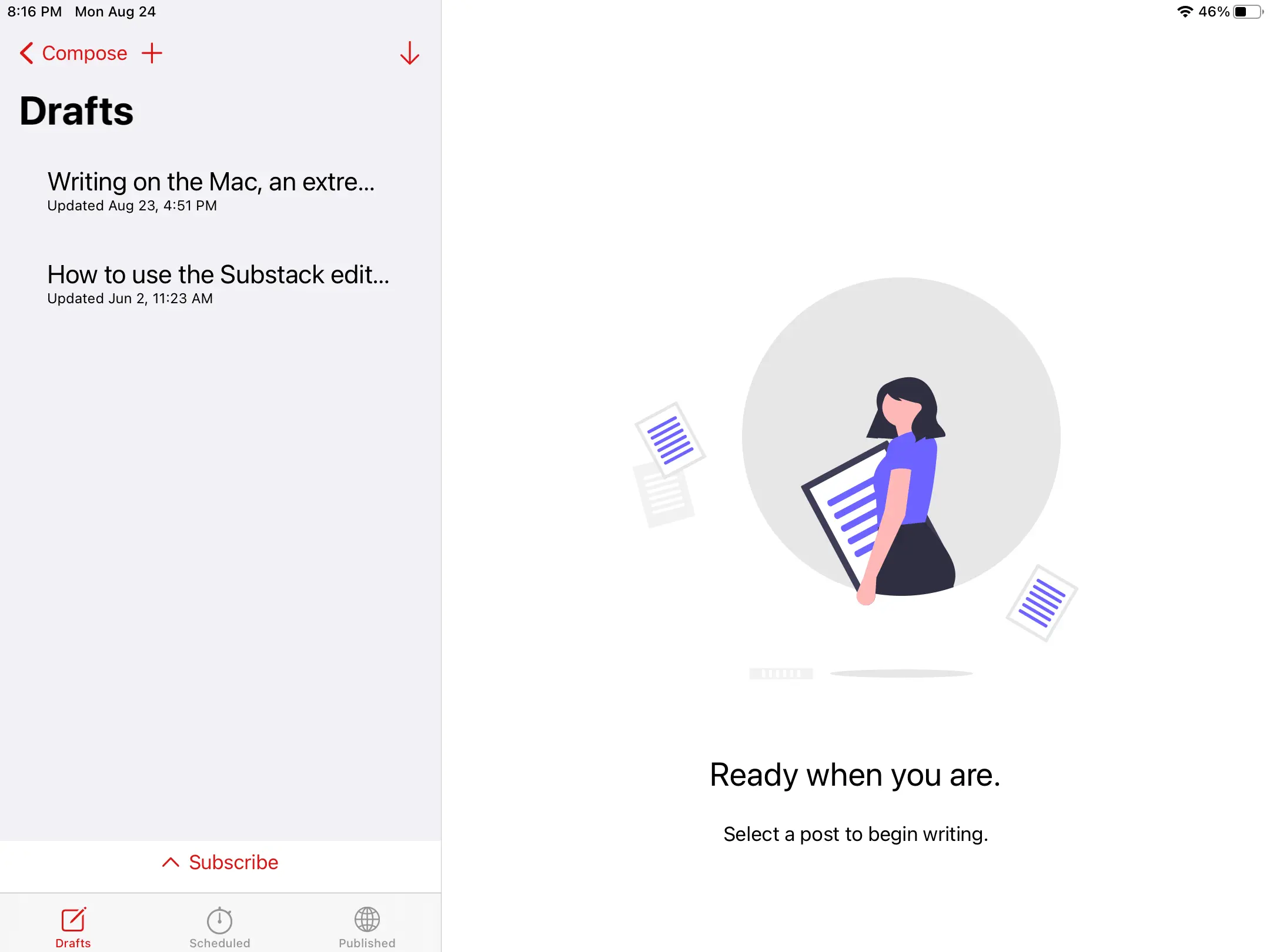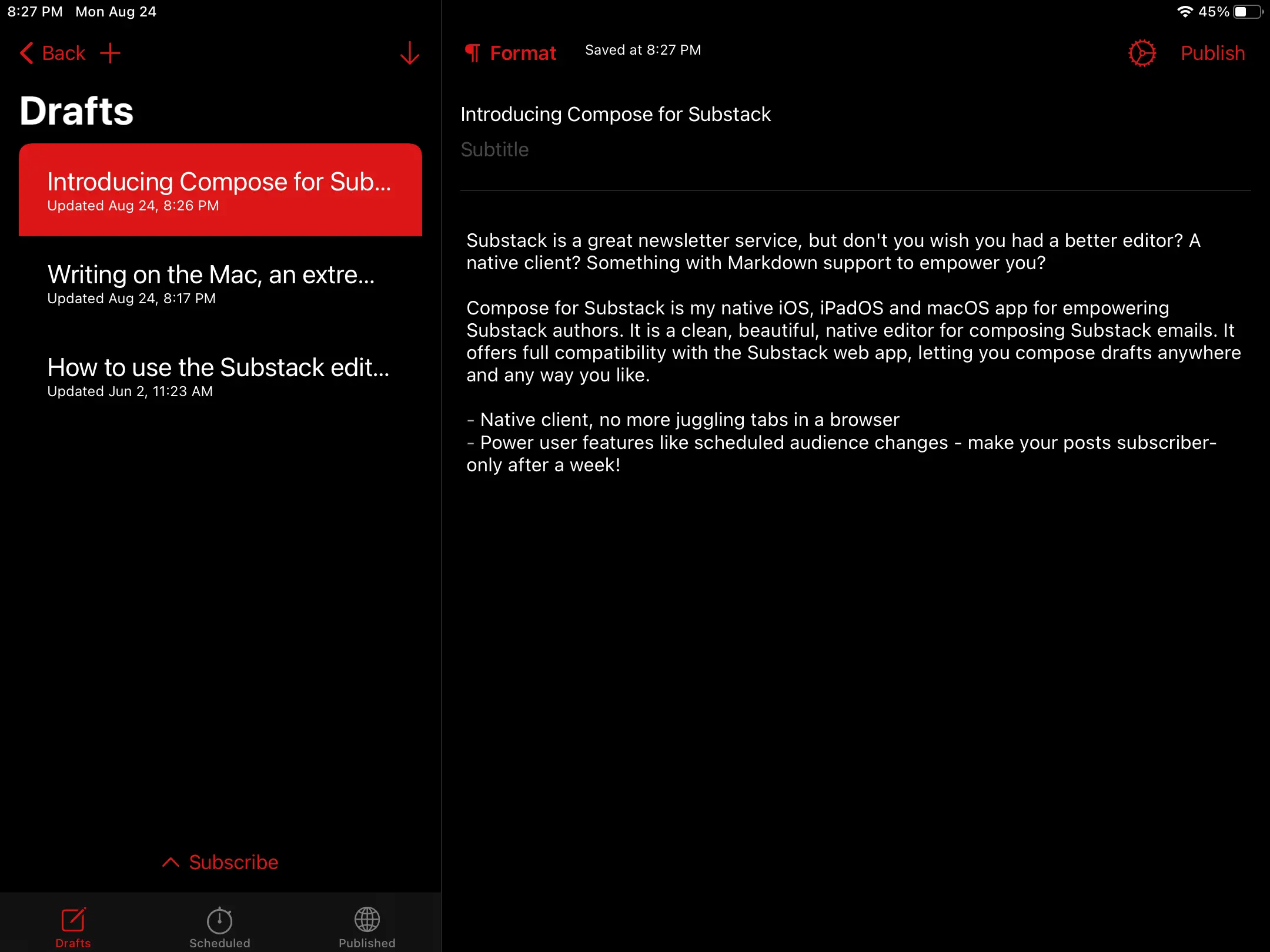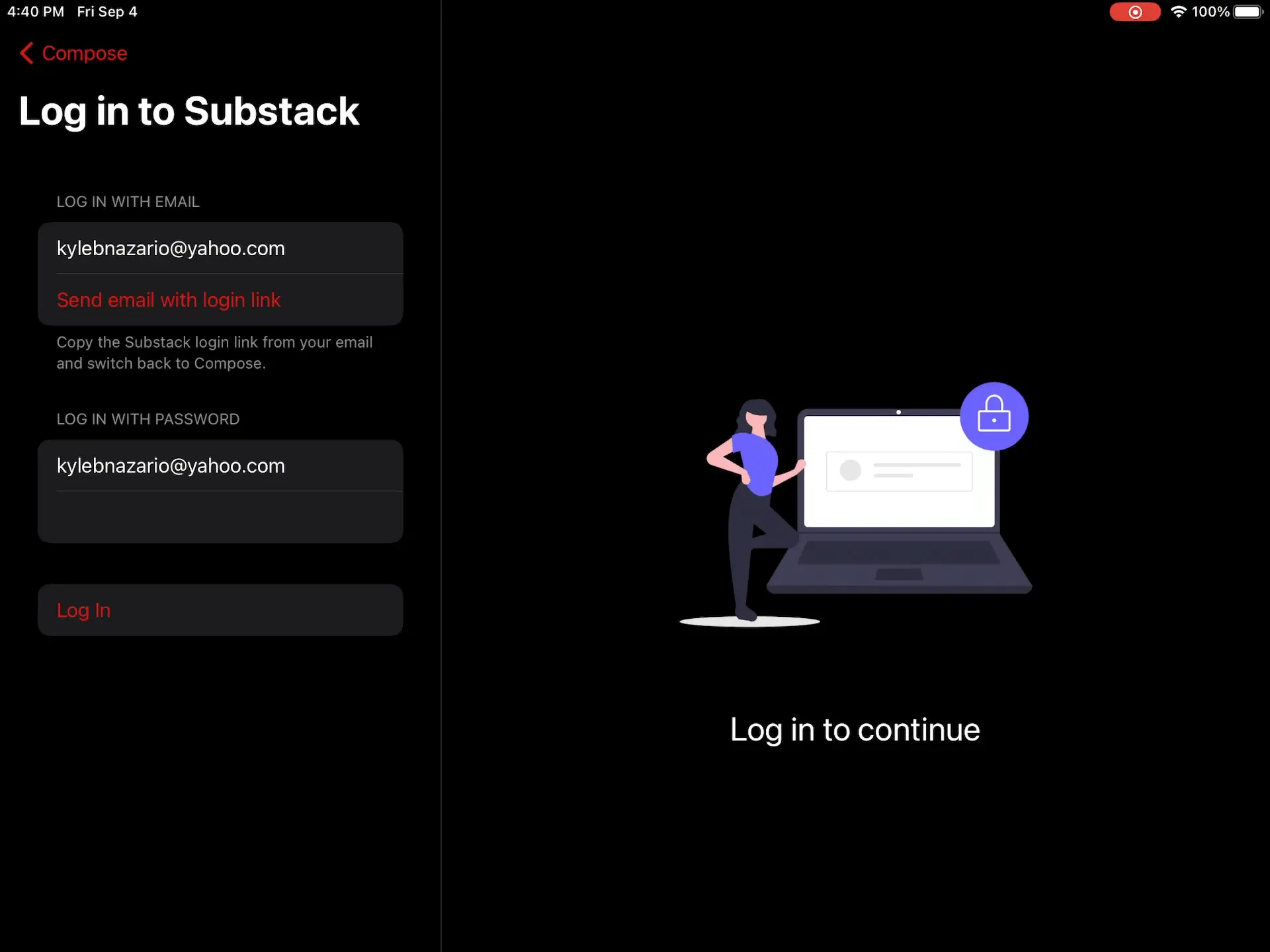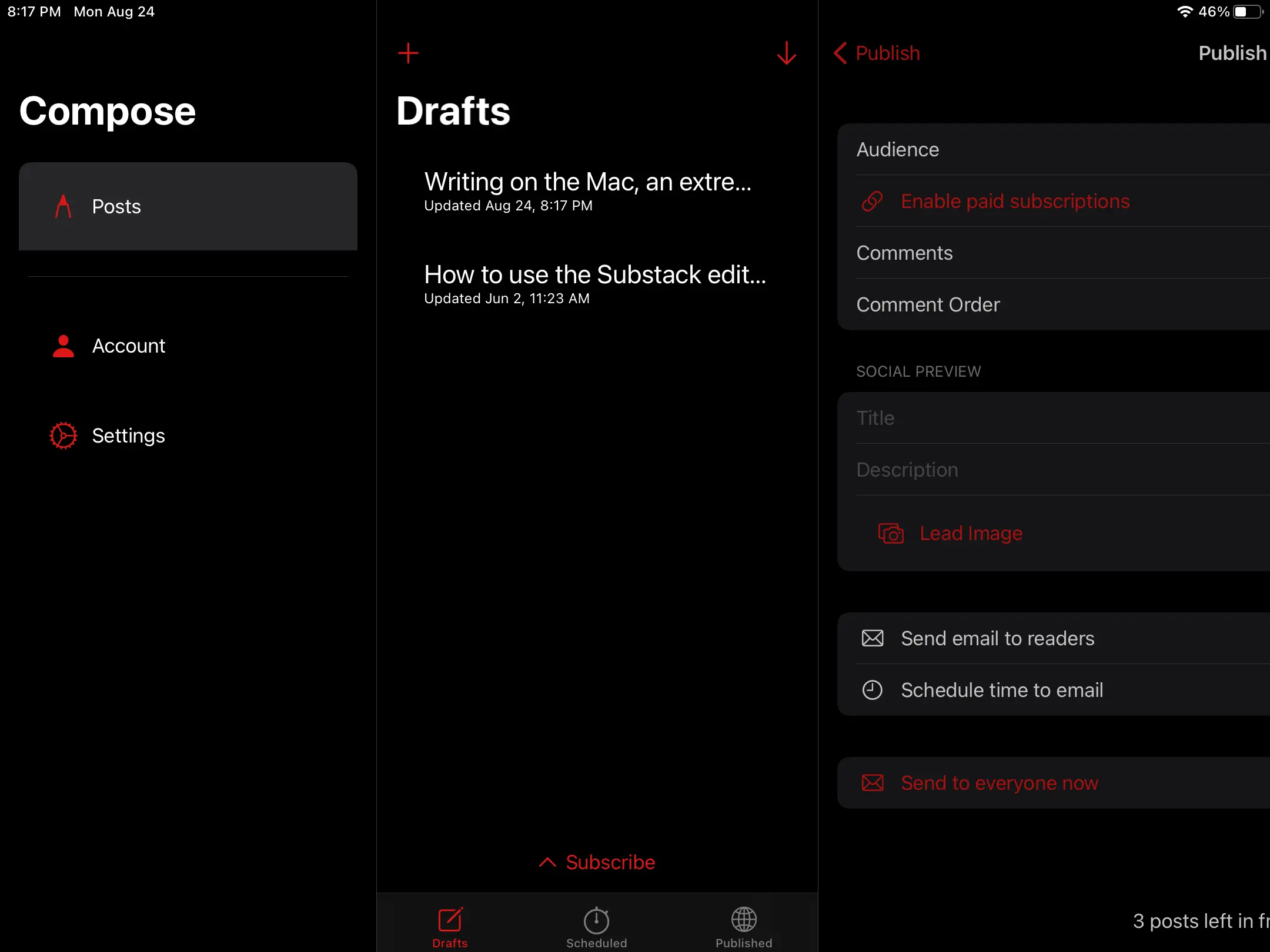The time I went stir-crazy during Covid and reverse-engineered Substack’s private API

Via Stable Diffusion
I try to spend my time on this blog showcasing things I’m proud of - cool side projects, AI tricks, clever reactive programing, that kind of thing.
But I also wanted to once, permanently, write down what happened to my least successful side project. It’s the time I poured hundreds of hours into a terrible app no one used.
It’s time to write about the time I went stir-crazy during COVID and reverse-engineered Substack’s private API.
The setting
I was in a bad headspace in June 2020. I was living across the country from my friends and family in a small one-bedroom apartment. COVID lockdowns were in effect. I’d barely seen anyone in person except my partner for months.
My job was frustrating. I was working as a frontend developer at a local SaaS company that was, well, chaotic. To give a sense of things, our DevOps guy caught a company VIP browsing 4Chan at work. With one year of experience and no computer science degree, I wanted a new job but could not get one.
I couldn’t change my resume, so I fixated on gaining notoriety with a side project. Make something amazing and maybe somebody at a good company would notice and offer a golden ticket out of my dreary day job (this did not work).
The idea
What to make? Well, in another life, I actually worked as a writer and journalist, so I decided to make an app for writers.
At this point, Substack didn’t have any kind of native app. I thought that was strange. Why should Substack writers have to compose newsletters in a web app, even on an iPad? Also, why should they have to use a simple rich text web editor? Why not let them write in Markdown?
Thus, Compose for Substack was born.
The app
It would be a native iOS, iPadOS and macOS app for newsletter authors. You’d compose Substack newsletter drafts using Markdown, then save and publish, all from a well-designed, native interface.

I didn’t have any iOS or macOS development experience, but Apple had just announced version 2 of SwiftUI. SwiftUI is their declarative framework for writing apps. It felt similar to React, which I knew somewhat well, and so I decided Compose should be written in SwiftUI. This plan seemed like the best way to create a high-quality, native iOS and macOS interfaces without learning the intricacies of UIKit and AppKit.
If you are an Apple ecosystem developer, you may already see some problems with this idea.
The API
Compose for Substack had an ambitious goal - total interoperability with the Substack web app. My goal was to let the user start a draft in Compose, then view it substack.com and have it be exactly the same.
For this reason, Compose only lightly used CloudKit and Core Data. The most important data, the blog posts, was actually stored on Substack’s servers as a normal draft post - as if the user had written it on substack.com.
This (way too ambitious) goal required reverse-engineering Substack’s private, undocumented drafts API. I played around with the web editor, keeping an eye on the network tab of the Chrome dev tools. I traced every request, building a mental model of how Substack’s frontend communicated with the backend.
I could see why they hadn’t opened it to third-parties. One of the properties on the draft response object actually used the ❤ character as a property key, I think to indicate how many favorites it had.
If you tried to load data for a user’s publication, it just returned a whole kitchen sink. Look at all this.
// SubstackPublication.swift
import Foundation
struct SubstackPublication: Codable {
let id: Int?
let name: String? = nil
let type: String? = nil
let homepageType: String? = nil
let logoURL, logoURLWide: String?
let subdomain: String?
let authorID: Int?
let copyright: String? = nil
let customDomain: String?
let customDomainOptional: Bool? = nil
let emailBannerURL: String? = nil
let emailFrom: String? = nil
let trialEndOverride: String? = nil
let emailFromName: String? = nil
let supportEmail: String? = nil
let firstEnabledPaymentsAt: String? = nil
let heroImage: String? = nil
let heroText: String? = nil
let requireClickthrough: Bool? = nil
let themeVarBackgroundPop: String? = nil
let defaultCoupon: String? = nil
let communityEnabled: Bool? = nil
let themeVarCoverBgColor: String? = nil
let coverPhotoURL: String? = nil
let themeVarColorLinks: Bool? = nil
let defaultGroupCoupon: String? = nil
let paymentsEnabled: Bool? = nil
let createdAt: String? = nil
let podcastEnabled: Bool? = nil
var pageEnabled: Bool? = nil
var applePayDisabled: Bool? = nil
let fbPixelID: Int? = nil
let gaPixelID: Int? = nil
let twitterPixelID: Int? = nil
let podcastTitle: String? = nil
let podcastFeedURL: String? = nil
let hidePodcastFeedLink: Bool? = nil
let paymentsSurveyStatus: Int? = nil
let minimumGroupSize: Int? = nil
let parentPublicationID: Int? = nil
let bylinesEnabled: Bool? = nil
let bylineImagesEnabled: Bool? = nil
let postPreviewLimit: Int? = nil
let defaultWriteCommentPermissions: String?
let defaultPostPublishSendEmail: Bool?
let googleSiteVerificationToken: String? = nil
let pauseState: String? = nil
let language: String? = nil
let paidSubscriptionBenefits: String? = nil
let freeSubscriptionBenefits: String? = nil
let foundingSubscriptionBenefits: String? = nil
let parentAboutPageEnabled: Bool? = nil
let inviteOnly: Bool? = nil
let subscriberInvites: Int? = nil
let defaultCommentSort: String?
let plans: String? = nil
let stripeCountry: String? = nil
let authorName: String? = nil
let authorPhotoURL: String? = nil
let authorBio: String? = nil
let hasChildPublications: Bool? = nil
let hasPublicUsers: Bool? = nil
let hasPosts: Bool? = nil
let hasPodcast: Bool? = nil
let hasSubscriberOnlyPodcast: Bool? = nil
let hasCommunityContent: Bool? = nil
let twitterScreenName: String? = nil
let draftPlans: String? = nil
let baseURL: String?
let hostname: String?
let isOnSubstack: Bool? = nil
let parentPublication: String? = nil
let childPublications: Array<String>? = nil
let siblingPublications: [String]? = nil
enum CodingKeys: String, CodingKey {
case id
case logoURL = "logo_url"
case logoURLWide = "logo_url_wide"
case subdomain
case authorID = "author_id"
case customDomain = "custom_domain"
case coverPhotoURL = "cover_photo_url"
case defaultWriteCommentPermissions = "default_write_comment_permissions"
case defaultPostPublishSendEmail = "default_post_publish_send_email"
case defaultCommentSort = "default_comment_sort"
case baseURL = "base_url"
case hostname
}
}The API wasn’t bad, just messy and not built for outside use. It took a lot of experimentation to decipher which properties to send in PUT requests to save updated newsletter drafts.
One of the hardest parts was reverse-engineering how Substack saved post contents. It looked like they were using Prosemirror and saving the text as one big JSON object. I had to write what was, as far as I knew, the world’s only Swift-language Markdown-Prosemirror converter. I’m proud of that one.
The editor
I also faced the small issue that no one had written an open-source text editor that was exactly what I wanted. Lots of editors had Markdown shortcuts. If you typed **hello**, editors with Markdown shortcuts removed the asterisks and left hello in bold.
I wanted an editor like Byword (which I am using to write this post), which uses Markdown patterns to apply formatting as you type, without removing the formatting characters. If you type **hello** in Byword, it leaves the asterisks and makes the “hello” between them bold.

Nothing fit, so I learned just enough UIKit and AppKit to write a text editor that formats as you type. It took a long time and a lot of effort, and it still slows down if you write too much, but it worked. The editor took Markdown, and, after the user had stopped tpyping for a few seconds, converted it to Prosemirror and synced it to substack.com.
That was about the extend of my SwiftUI success.
The framework

I like SwiftUI. Interfaces are easier to build declaratively, one reason React has taken over frontend web dev. It feels more intuitive than making subclasses and overriding parent functions, like in UIKit.
However.
SwiftUI has enough rough edges, some indie devs have sworn off it entirely. Every year, though, Apple makes it more powerful and less buggy.
In 2020, the rough edges were twice as bad. AppKit-flavored SwiftUI, which of course I picked, is twice that. I picked SwiftUI to avoid learning AppKit and UIKit, but it lacked so much I still ended up learning both.
This was my mistake. To create a high-quality, boutique iOS & Mac app, avoid brand-new frameworks with tons of rough edges. 2020-era SwiftUI was a bad choice for a junior trying to make something nice.
The price
The app would be free to download. You would be able to publish three posts before I’d require a $5 / month subscription.
The subscription was necessary because this app would require ongoing updates to keep it compatible with the Substack API. “Lifetime purchase” was also a bad option, since Substack could cut me off at any time. Better to charge month to month.

I investigated in-app payments. On one hand, RevenueCat seemed like a fast way to get out the door. StoreKit seemed complicated.
I still picked StoreKit. If the app made money, I didn’t want to give RevenueCat a cut. Plus, using a third-party StoreKit library somehow seemed like cheating.
The launch
You are probably starting to sense some red flags. Reader, I sensed none of them.
For example, one small red flag was the audience. At no point during development did I:
- Test the app with Substack writers
- Ask writers if they wanted a native editing app
- Ask writers if they wanted to write in Markdown
- Ask writers if they would pay for an app enabling them to do these things
I plowed on ahead and launched the iOS and iPadOS versions of the app in the fall of 2020.
After several weeks, my total subscribers were…
Zero.
I can’t remember how many people downloaded it, but it wasn’t more than 40. It is the worst-performing side project I’ve ever made.
I was so embarrassed I pulled it off the App Store after just a few weeks. The product-market mismatch was so obvious, more development seemed like a waste.
The lessons
If nothing else, the whole fiasco was a good learning experience.
- Product-market fit is everything. If you don’t have something people will pay for, nothing else matters.
- Technical competence loses to product-market fit every time.
- Get your product in front of users as soon as possible.
- Use proven, established tools you know well so you can build something good quickly.
- Reverse-engineering private APIs is fun but a risky business idea.
- Either build something for yourself, or something you’re extremely confident other people will use.
- Use third-party tools like RevenueCat or Firebase if they help you build faster. It doesn’t matter if they take a bigger cut of your profits. Your top priority is to get out the door and figure out if your app is something people actually want.
The project wasn’t a total loss. I spent some time breaking out my text editor into an open source project, HighlightedTextEditor. It’s been decently successful - 643 stars, with a fair number of issues and PRs on GitHub. I’m glad people are using it, and happy to give back to the iOS dev community.
It’s the least I can do, since I can’t make a good Substack app 😉.